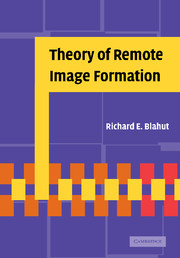Book contents
- Frontmatter
- Contents
- Preface
- Acknowledgements
- 1 Introduction
- 2 Signals in one dimension
- 3 Signals in two dimensions
- 4 Optical imaging systems
- 5 Antenna systems
- 6 The ambiguity function
- 7 Radar imaging systems
- 8 Diffraction imaging systems
- 9 Construction and reconstruction of images
- 10 Tomography
- 11 Likelihood and information methods
- 12 Radar search systems
- 13 Passive and baseband surveillance systems
- 14 Data combination and tracking
- 15 Phase noise and phase distortion
- References
- Index
1 - Introduction
Published online by Cambridge University Press: 19 August 2009
- Frontmatter
- Contents
- Preface
- Acknowledgements
- 1 Introduction
- 2 Signals in one dimension
- 3 Signals in two dimensions
- 4 Optical imaging systems
- 5 Antenna systems
- 6 The ambiguity function
- 7 Radar imaging systems
- 8 Diffraction imaging systems
- 9 Construction and reconstruction of images
- 10 Tomography
- 11 Likelihood and information methods
- 12 Radar search systems
- 13 Passive and baseband surveillance systems
- 14 Data combination and tracking
- 15 Phase noise and phase distortion
- References
- Index
Summary
Our immediate environment is a magnificent tapestry of information-bearing signals of many kinds: some are man-made signals and some are not, reaching us from many directions. Some signals, such as optical signals and acoustic signals, are immediately compatible with our senses. Other signals, as in the radio and radar bands, or as in the infrared, ultraviolet, and X-ray bands, are not directly compatible with human senses. To perceive one of these signals, we require a special apparatus to convert it into observable form.
A great variety of man-made sensors now exist that collect signals and process those signals to form some kind of image, normally a visual image, of an object or a scene of objects. We refer to these as sensors for remote surveillance. There are many kinds of sensors collected under this heading, differing in the size of the observed scene, as from microscopes to radio telescopes; in complexity, as from the simple lens to synthetic-aperture radars; and in the current state of development, as from photography to holography and tomography. Each of these devices collects raw sensor data and processes that data into imagery that is useful to a user. This processing might be done by a digital computer, an optical computer, or an analog computer. The development and description of the processing algorithms will often require a sophisticated mathematical formulation.
- Type
- Chapter
- Information
- Theory of Remote Image Formation , pp. 1 - 28Publisher: Cambridge University PressPrint publication year: 2004



